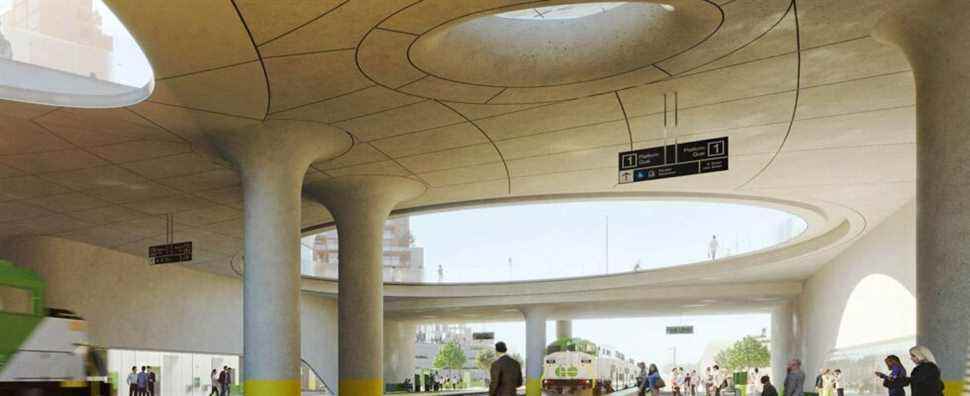For now, only fields can be found at the intersection of 6th Line and 20th Sideroad in Innisfil, a rural town 90 kilometers north of Toronto. But within ten years, the municipal administration wants to build a smart, futuristic city, centered on a new suburban train station.
This would be a radical transformation for Innisfil, a municipality of about 36,000 inhabitants with little density: at the end of the project, the local population could quadruple. The administration plans to build a concentric neighborhood similar to a garden city, suitable for pedestrians, where it will be possible to get to work or the GO train station – whose construction could begin in 2022 – in about ten minutes. .
The municipality is focusing on establishing a local economy focused on the new technology sector to attract residents and jobs. “We are developing an ecosystem for young shoots, since this is where the market opportunities lie”, explains Dan Taylor, a native of Beaconsfield, west of the island of Montreal, who is the catalyst. of economic development in the Town of Innisfil. The Orbit is a bit of “a dream,” says Frank Clayton, co-founder of the Center for Urban Research and Land Development at Ryerson University. “But dreams command attention. “
Change needed
The current pace of life in the municipality is not sustainable, argues Dan Taylor. Before the pandemic, eight in ten people left Innisfil every day to go to work in Barrie or the greater Toronto area. Without change, he says, Innisfil will remain a dormitory community. If the municipality is to become more “robust,” says Dan Taylor, more residents will have to work in Innisfil.
According to the Montrealer, the situation is favorable to the development of the local economy, because the pandemic has prompted many residents of the greater Toronto area to abandon the city. Simcoe County, home to Innisfil and Barrie, was one of the top destinations for the more than 50,000 Torontonians who left Queen City in 2020.
However, University of Toronto studies professor Richard Florida doubts the possibility of attracting start-ups, which are “more and more urban”. Especially since some of the people who left the city in 2020 are on their way home. “It’s hard to find a low-density place that has successfully transformed into a dense and innovative community,” says Shauna Brail, a professor at the University of Toronto, who is interested in smart cities. However, the municipality can rely on innovative foundations to achieve its objectives. In 2017, Innisfil reached an agreement with the American company Uber to make it its public transport, a first agreement of its kind in the country. “Whether it served residents better than the bus or not, the municipality was ready to try something different,” says Shauna Brail.
In the shadow of Sidewalks Lab
The “smart city” concept does not, however, have the best reputation in the Toronto area. Under a shower of criticism, in May 2020, Sidewalks Lab, a subsidiary of Alphabet – parent company of Google -, ended the Quayside project, on the shores of Lake Ontario, in Toronto. The area, filled with a multitude of cameras and sensors, made many fear constant surveillance.
“I wish we had learned our lesson about data collection,” says Dan Taylor. How can we use technologies to create a functional city? Innisfil could bury its waste or install optical fiber underground. “Maybe the red light could only be red when there are cars,” he also gives as an example.
Uncertain trends
The development of Quayside in Toronto is different from that of The Orbit in Innisfil, notes Shauna Brail. Firstly because of its size, but also because of the group responsible for its implementation. “Quayside was run by Waterfront Toronto, a tri-government organization, while The Orbit is more run by the municipality,” she notes.
On August 9, Innisfil received a helping hand from the provincial government, which issued a ministerial zoning order, which allows the Minister of Municipal Affairs to control the use of any land in the province. The measure accelerated the private financing necessary for the construction of the station. “Real estate development will always take place near transport infrastructure, so why not do it responsibly instead? Wrote by email Tim Cane, director of The Orbit project.
This station, however, may not become the engine the City hopes for, believes Frank Clayton. The growth near GO stations in Toronto is recent, notes the town planner, and is explained by the passage of trains every fifteen minutes, which is not won at Innisfil.
Right now there is only dirt on the corner of 6th Line and 20th Sideroad. The end result may not match the plan on the mockups, says Shauna Brail, “but if we are to encourage innovation and new ways of thinking, we need to have visionary thinkers and leaders,” she concludes.
